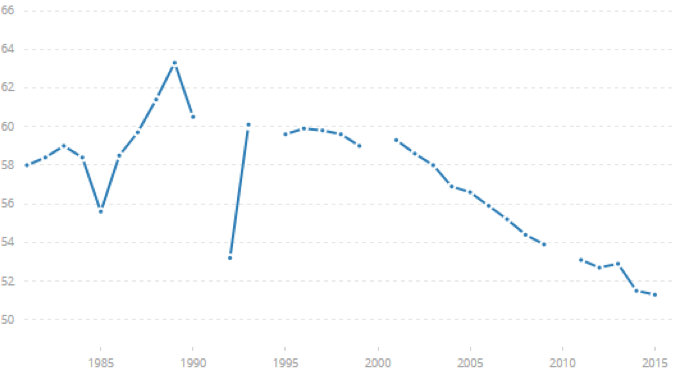Social Risks in Brazil: Poverty and Urbanization
Author: Matthew Tai
Over the past decade, Brazil has substantially managed to bring down its traditionally high levels of inequality and poverty. According to the World Bank’s international poverty line, poverty in Brazil decreased from 21 percent of the population in 2005 to 8.7 percent in 2015. Extreme poverty, defined as households whose income is less than $1.90 USD per day, declined from 9.6 percent to 4.3 percent of the population over the same period. Moreover, Brazil’s Gini coefficient – the most commonly used inequality measure – declined from 0.65 in 1990 to 0.51 in 2015, where the closer the index to 1, the more unequal, according to World Bank’s data. Economic growth and deliberate social inclusion policies such as targeted social programs and minimum wage increases instituted by the government helped to reduce inequality. However, this type of growth invariably leads to urbanization, which refers to the development of urban areas and the migration of people from rural areas into the city centres. In the case of Brazil, the country has experienced staggering urbanization in the last century with 80% of Brazilians now living in urban areas such as Rio de Janeiro and São Paulo.
HINI Index- Brazil (From 1981-2015)

Source: World Bank Estimates
Although urbanization is generally viewed as a positive indicator of growth and development, the rate at which it is occurring in Brazil is unsustainable. In fact, the geographical split of the wealthy and the poor within one area is a common characteristic of urbanisation. Because of this, Brazil’s inequality still remains relatively high and weak public services result in institutional inequality. As Brazil’s cities increase in density, the quality and standard of living in these cities will decrease unless public infrastructure projects keep pace, as cities do not have the time or resources to accommodate and employ migrants. Moreover, as cities grow denser, transportation infrastructure will be placed under more strain in the event of large-scale incidents or natural disasters. As a result, many migrants arrive to find themselves living in poor conditions and fighting for a degree of quality of life in Brazil’s city hubs, leading to informal settlements known as favelas, which are slums in the country’s metropolitan areas suffering from underdevelopment and below-par standards of living. For example, in Rio de Janeiro alone, about a fifth of the six million inhabitants live in several hundred favelas. All these favelas suffer from many health and safety problems. Because many favelas are situated on steep hills that are unable to support structurally safe homes, many are far from shops, schools, and transportation routes. Additionally, favelas are prone to disease outbreaks due to the poor sanitation and lack of water.
While low standards of living and poverty are major issues of urbanisation, another enormous problem for Brazil is the underdevelopment of the country’s transportation network. According to the World Economic Forum, Brazil ranks 107th out of 144 countries in the level of infrastructure development with roads and ports desperately in need of an upgrade while railroad infrastructure remains few and uncompetitive. The use of trains for long distance transportation of passengers is restricted to a few urban tourist routes, while cargo transportation is mostly restricted to raw minerals. Furthermore, Brazil faces a housing crisis, with estimates placing the housing shortage in the country at around 7 million units, in addition to speculative real-estate practices. These issues have to be addressed for the progress and development of a country like Brazil.
Inadequate infrastructure as a result of rapid urbanization is a significant business risk. To mitigate this risk posed, investors and businesses operating in the same geographic regions can work together and partner to invest in infrastructure. Although this may require large capital investment, companies that build infrastructure will likely see a return on their investment. Infrastructure investments will boost the construction sector and lead to higher productivity and growth. Furthermore, an improved transportation system can facilitate employee movement, lower the cost of shipping raw materials and goods for sale, and it can build goodwill between the investing companies and the local community. For example, this can involve building bus routes directly to the workplace, constructing light rail networks, or partnering with the local government to push for more effective public transportation.
In addition to forming private partnerships, it is important that investors and companies coordinate and work with the government to regulate social responsibility and commit to social development goals. Companies can also make use of public-private partnerships (PPPs), which are considered one of the main instruments used by the Brazilian government to attract investments in infrastructure, principally in transportation facilities such as railways, roads and ports, but also in social service facilities such as hospitals, clinics and schools. By partnering with public agencies, investors can have a greater understanding on what projects can improve the country’s infrastructure deficit, as well as the diversification of their holdings to limit risks and development costs, making it more feasible than self-funded infrastructure projects.

